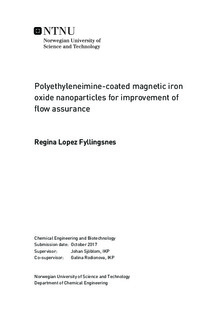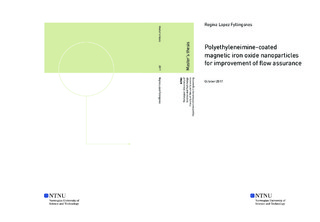| dc.description.abstract | This thesis aims to gain further insight into how the naphthenic acids
(NA), which cause different problems with respect to flow assurance, can
be removed from the water phase. The main objective has been to test
how effective the polyethyleneimine functionalized magnetic iron oxide
nanoparticles are to remove phenylacetic acid, which functioned as model
naphthenic acid from water.
The first part of the experimental work was concerned with the adsorp-
tion of polyethyleneimine onto the nanoparticle surface. The zeta potentials
as function of pH were determined for both the iron oxide nanoparticles
and the polymer. From superimposing the isoelectric points for both syn-
thesised and purchased iron oxide nanoparticles and comparing them to the
zeta potentials for polyethyleneimine, pH 8 was chosen.
Since the confidence for the true mean of the zeta potential was low
for the functionalized iron (II, III) oxide core, using shaking overnight, the
functionalization was done again with iron (III) oxide as core. In a new
approach the polyethyleneimine was added to the supernatant of iron (III)
oxide after centrifugation followed by sonication.
The new functionalized nanoparticles gave a high confidence for the
zeta potentials and were attracted to an external magnetic field. The spe-
cific surface area for the functionalized iron (III) oxide nanoparticles was
iiidetermined to be 62.5 ± 0.2 with 95% confidence, using gas adsorption.
The composition with respect to mass was determined to be 6 wt% from
running a thermogravimetric analysis. Hence, the surface excess of poly-
ethyleneimine was calculated to be 0.9 mg/m 2 .
In the second part of the experiments, test adsorptions of the model
acid were conducted using the polyethyleneimine coated iron (III) oxide
nanoparticles. At pH 8 the adsorption of the phenylacetic acid was negli-
gible. A new calibration curve was made at pH 4.5. Two different values
for the surface excess were obtained. When concentration of the bulk acid
prior to the adsorption was estimated from the calibration curve, the surface
excess was calculated to be 0.16 mg/m 2 , whereas 0.28 mg/m 2 was procured
using the value from the balance.
Since previous research has indicated that the chain length of the poly-
mer determines the adsorption and the surface excess is independent of the
chain length, it was concluded to continue using polyethyleneimine in the
functionalization of iron (III) oxide, but with a lower average molecular
weight. | |

